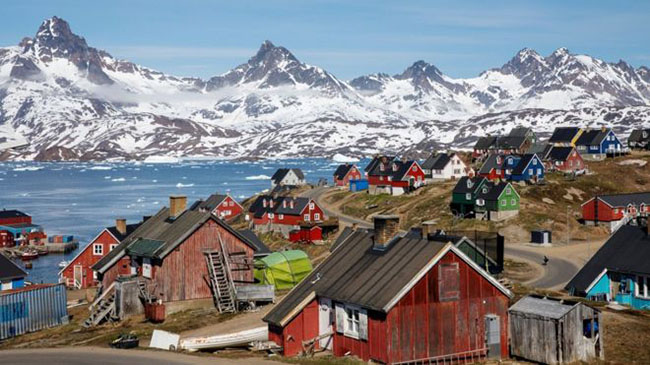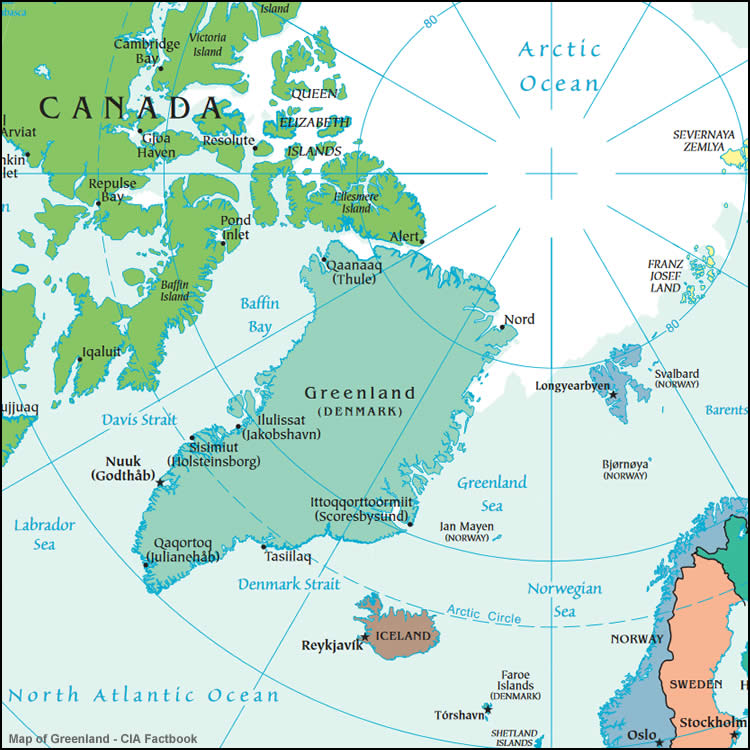

Trump wanted to buy Greenland. Everyone thought it was a joke. Prime Minister Mette Frederiksen of Denmark said No that the idea was absurd. It unleashed a torrent of jokes on late-night television and social media and finally exploded into a serious diplomatic rupture between the United States and one of its longtime allies. There is a political correct way to go about this... but as always Trump missed the opportunity and did it his way. The world considers him a joke at this point.
-
NASA scientists track Greenland's melting ice, and the findings are not good Market Watch - August 16, 2019
Aboard a NASA Research plane over Greenland - The fields of rippling ice 500 feet below the NASA plane give way to the blue-green of water dotted with irregular chunks of bleached-white ice, some the size of battleships, some as tall as 15-story buildings. Like nearly every other glacier on Greenland, the massive Kangerlussuaq is melting. In fact, the giant frozen island has seen one of its biggest melts on record this year. NASA scientist Josh Willis is now closely studying the phenomenon in hopes of figuring out precisely how global warming is eating away at Greenland's ice.
-
Scientist captures melting ice sheet in viral photo CNN - August 16, 2019
The devastating impact of a warming planet has been captured in a stunning image of sled dogs walking on Greenland's melting ice sheet.
-
Greenland's ice is melting at the rate scientists thought would be our worst-case scenario in 2070 Business Insider - August 16, 2019
Greenland is known for its glaciers, but in the past month, the island has shed ice and taken on fire.
-
Earth's future is being written in fast-melting Greenland PhysOrg - August 20, 2019
Fossil fuel drilling could be contributing to climate change by heating Earth from within

Greenland is an autonomous country of the Kingdom of Denmark, located between the Arctic and Atlantic oceans, east of the Canadian Arctic Archipelago. Though physiographically a part of the continent of North America, Greenland has been politically and culturally associated with Europe (specifically Norway and Denmark, the colonial powers, as well as the nearby island of Iceland) for more than a millennium. The majority of its residents are Inuit, whose ancestors began migrating from the Canadian mainland in the 13th century, gradually settling across the island.
Greenland is the world's largest island (Australia and Antarctica, both larger than Greenland, are generally considered to be continental landmasses rather than islands). Three-quarters of Greenland is covered by the only permanent ice sheet outside Antarctica. With a population of about 56,480 (2013), it is the least densely populated territory in the world. About a third of the population live in Nuuk, the capital and largest city. The Arctic Umiaq Line ferry acts as a lifeline for western Greenland, connecting the various cities and settlements.
Greenland has been inhabited at intervals over at least the last 4,500 years by Arctic peoples whose forebears migrated there from what is now Canada. Norsemen settled the uninhabited southern part of Greenland beginning in the 10th century, having previously settled Iceland to escape persecution from the King of Norway and his central government. These Norsemen would later set sail from Greenland and Iceland, with Leif Erikson becoming the first known European to reach North America nearly 500 years before Columbus reached the Caribbean islands. Inuit peoples arrived in the 13th century. Though under continuous influence of Norway and Norwegians, Greenland was not formally under the Norwegian crown until 1262. The Norse colonies disappeared in the late 15th century when Norway was hit by the Black Death and entered a severe decline. Soon after their demise, beginning in 1499, the Portuguese briefly explored and claimed the island, naming it Terra do Lavrador (later applied to Labrador in Canada).
In the early 18th century, Danish explorers reached Greenland again. To strengthen trading and power, DenmarkŠNorway affirmed sovereignty over the island. Because of Norway's weak status, it lost sovereignty over Greenland in 1814 when the union was dissolved. Greenland became Danish in 1814, and was fully integrated in the Danish state in 1953 under the Constitution of Denmark.
In 1973, Greenland joined the European Economic Community with Denmark. However, in a referendum in 1982, a majority of the population voted for Greenland to withdraw from the EEC, which was effected in 1985. Greenland contains the world's largest and most northerly national park, Northeast Greenland National Park (Kalaallit Nunaanni nuna eqqissisimatitaq). Established in 1974, and expanded to its present size in 1988, it protects 972,001 square kilometres (375,292 sq mi) of the interior and northeastern coast of Greenland and is bigger than all but twenty-nine countries in the world. Greenland is divided into five municipalities Š Sermersooq, Kujalleq, Qeqertalik, Qeqqata, and Avannaata. Greenland does not have an independent seat at the United Nations.
In 1979, Denmark granted home rule to Greenland, and in 2008, Greenlanders voted in favor of the Self-Government Act, which transferred more power from the Danish government to the local Greenlandic government. Under the new structure, in effect since 21 June 2009, Greenland can gradually assume responsibility for policing, judicial system, company law, accounting, and auditing; mineral resource activities; aviation; law of legal capacity, family law and succession law; aliens and border controls; the working environment; and financial regulation and supervision, while the Danish government retains control of foreign affairs and defense. It also retains control of monetary policy, providing an initial annual subsidy of DKK 3.4 billion, which is planned to diminish gradually over time. Greenland expects to grow its economy based on increased income from the extraction of natural resources. The capital, Nuuk, held the 2016 Arctic Winter Games. At 70%, Greenland has one of the highest shares of renewable energy in the world, mostly coming from hydropower. Read more